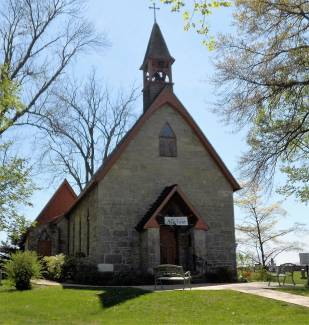Collection Name
About
Boonsboro church pays tribute to former slaves
All eight founding members of St. Mark's Episcopal Church on Lappans Road were slaveholders, and members of the church in the 1800s profited from slave labor. And it is believed that slaves might have helped construct the church.
Current leaders of the church worked on Sunday to make amends for the church's ties to slavery, unveiling a monument recognizing former slaves buried in a church cemetery and discussing recently discovered history about the church, including the story of a slave couple owned by members of the congregation. The couple fled the area after they discovered one of their daughters was about to be sold as a slave.
Isaac and LettyAnn Warfield fled over the Mason-Dixon Line to Williamsport, Pa., during the Civil War, but returned after the conflict and rejoined the church in the area where they had once been enslaved, said the Rev. Anne Weatherholt, pastor of St. Mark's Episcopal Church. The Warfields built a log house that still stands on nearby Breathedsville Road, and they are buried in the church's cemetery.
The work to examine the church's connection to slavery began after its governing body passed a resolution asking that the church look "seriously and prayerfully and with a sense of repentance" at the horror of slavery, the Rev. Heather Cook, bishop suffragan of the Diocese of Maryland, told about 60 people during a 3 p.m. service at the church at 18313 Lappans Road. The resolution also called for examining how the church had been "complicit" with slavery, she said.
"Now that's not an easy call to make, but it was felt it was time," Cook said.
The Diocese of Maryland took the resolution seriously and established a "truth-and-reconciliation commission," which urged churches to research their ties to slavery and come to terms with them, Cook said.
Emilie Amt, a member of the church and chairwoman of the history department at Hood College, agreed to research the church's past. Thanks to a yearlong sabbatical granted to her from Hood College, Amt was able to work full time on the church's history, including the fact that the first man and woman to be married at the church in 1849 were black. They were also slaves and owned by members of the church, she said.
Church officials already knew about the marriage, but Amt was able to unearth more details, including that Malinda James were freed in 1858 and moved to Hagerstown. But her husband, Jeremiah, was forced to be a slave until Maryland slaves were freed in 1864, Amt said.
When they were reunited, they lived in the Beaver Creek area, Amt said.
Other black history associated with the church was a balcony where slaves sat, segregated from white parishioners, Weatherholt said. Slave owners wanted slaves to be in the balcony so they could keep an eye on them, she said.
Church officials have plans to renovate the balcony, including pulling out conventional furniture and replacing it with seating that was typical of such segregated areas, Weatherholt said.
After a service in the church, guests filed outside to a historical marker in the cemetery honoring slaves and other blacks buried there. "May what we do in our day honor their memory," Weatherholt said.
The crowd then moved to witness the unveiling of another historical marker that recognized the church for its role as a hospital after the Civil War's Battle of Antietam. Services were not held at the church for six weeks due to the large number of people who were treated there. It is believed that there are marked and unmarked graves of soldiers in the churchyard.
"We pray and hope in our day that war may cease in all the world and the peace of God will prevail," Weatherholt said while unveiling the marker. Elizabeth Scott Shatto, director of the Heart of the Civil War Heritage Area, praised the church for telling the "whole story of God's people."
Photography by Albert L. Feldstein
